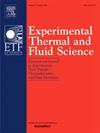An efficient offline sensor placement method for flow estimation
IF 3.3
2区 工程技术
Q2 ENGINEERING, MECHANICAL
Experimental Thermal and Fluid Science
Pub Date : 2025-03-22
DOI:10.1016/j.expthermflusci.2025.111448
引用次数: 0
Abstract
We present an efficient method to optimize sensor placement for flow estimation using sensors with time-delay embedding in advection-dominated flows. Our solution allows identifying promising candidates for sensor positions using solely preliminary flow field measurements with non-time-resolved Particle Image Velocimetry (PIV), without introducing physical probes in the flow. Data-driven estimation in advection-dominated flows often exploits time-delay embedding to enrich the sensor information for the reconstruction, i.e. it uses the information embedded in probe time series to provide a more accurate estimation. Optimizing the probe position is the key to improving the accuracy of such estimation. Unfortunately, the cost of performing an online combinatorial search to identify the optimal sensor placement in experiments is often prohibitive. We leverage the principle that, in advection-dominated flows, rows of vectors from PIV fields embed similar information to that of probe time series located at the downstream end of the domain. We propose thus to optimize the sensor placement using the row data from non-time-resolved PIV measurements as a surrogate of the data a real probe would actually capture in time. This optimization is run offline and requires only one preliminary experiment with standard PIV. Once the optimal positions are identified, the probes can be installed and operated simultaneously with the PIV to perform the time-resolved field estimation. We show that the proposed method outperforms equidistant positioning or greedy optimization techniques available in the literature.
一种有效的流量估计离线传感器放置方法
我们提出了一种有效的方法来优化传感器的位置,以流量估计使用时延嵌入传感器在平流占主导地位的流动。我们的解决方案允许仅使用非时间分辨粒子图像测速(PIV)的初步流场测量来识别有希望的传感器位置候选者,而无需在流动中引入物理探头。在平流占主导地位的流中,数据驱动估计通常利用时延嵌入来丰富传感器信息用于重建,即利用探针时间序列中嵌入的信息来提供更准确的估计。优化测头位置是提高估计精度的关键。不幸的是,在实验中进行在线组合搜索以确定最佳传感器位置的成本通常是令人望而却步的。我们利用的原理是,在平流主导的流动中,来自PIV场的向量行嵌入了与位于域下游端的探针时间序列相似的信息。因此,我们建议使用来自非时间分辨率PIV测量的行数据来优化传感器放置,作为真实探针实际及时捕获的数据的替代品。此优化是离线运行的,只需要使用标准PIV进行一次初步实验。一旦确定了最佳位置,探针可以与PIV同时安装和操作,以执行时间分辨场估计。我们证明了所提出的方法优于文献中可用的等距定位或贪婪优化技术。
本文章由计算机程序翻译,如有差异,请以英文原文为准。
求助全文
约1分钟内获得全文
求助全文
来源期刊

Experimental Thermal and Fluid Science
工程技术-工程:机械
CiteScore
6.70
自引率
3.10%
发文量
159
审稿时长
34 days
期刊介绍:
Experimental Thermal and Fluid Science provides a forum for research emphasizing experimental work that enhances fundamental understanding of heat transfer, thermodynamics, and fluid mechanics. In addition to the principal areas of research, the journal covers research results in related fields, including combined heat and mass transfer, flows with phase transition, micro- and nano-scale systems, multiphase flow, combustion, radiative transfer, porous media, cryogenics, turbulence, and novel experimental techniques.
 求助内容:
求助内容: 应助结果提醒方式:
应助结果提醒方式:


